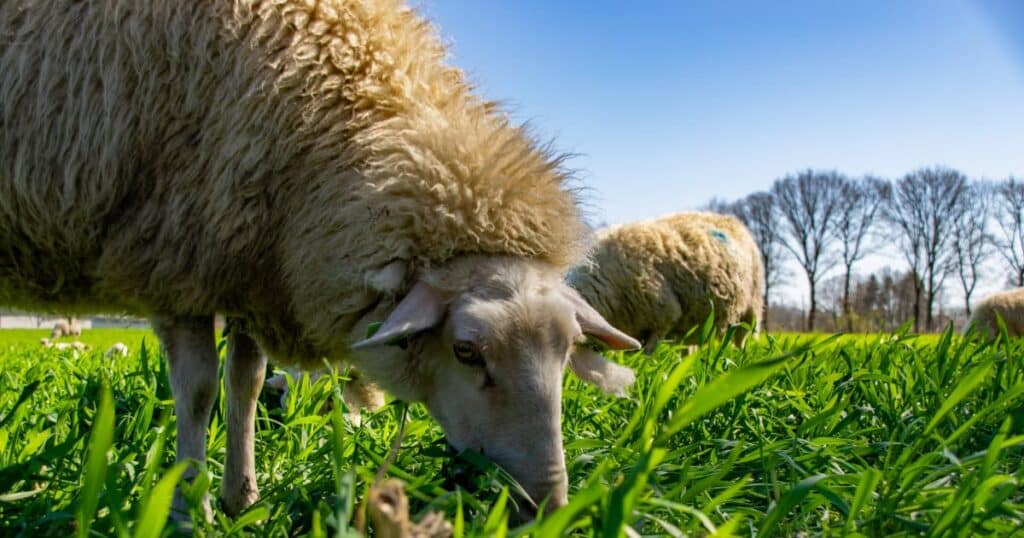If you’re to achieve and maintain a healthy flock, your sheep need specific amounts of energy, vitamins, energy, minerals, water, and fiber. Ensuring that the nutritional requirements of your flock are satisfied can be done in a number of different ways. Just like human beings and some other species, sheep’s dietary requirements can be satisfied with different combinations of food, and in this sheep nutrition guide we’ll explain the basic requirements sheep have to survive and thrive, and provide tips for what to feed your sheep for ideal growth and production.
Sheep, of course, are ruminants. Ruminants are animals that have compartmental stomachs. This type of stomach contains the following components:
- Rumen,
- Reticulum,
- Omasum, and
- Abomasum.
The rumen ensures that the sheep can eat plant material and keep it in the stomach for a length of time sufficient to let bacteria, fungi, and protozoa break down the material, so that it can be digested.
Energy Requirements
The energy requirements of sheep can be satisfied with carbohydrates and fat as well as excess protein in the animal’s diet. Carbohydrates are the most significant type of food that meets sheep’s energy requirements.
Concentrates (like grain) are rich in starch, and this is an important source of energy in a sheep’s diet. While forages offer cellulose and fiber, but it doesn’t provide as much energy as starch.
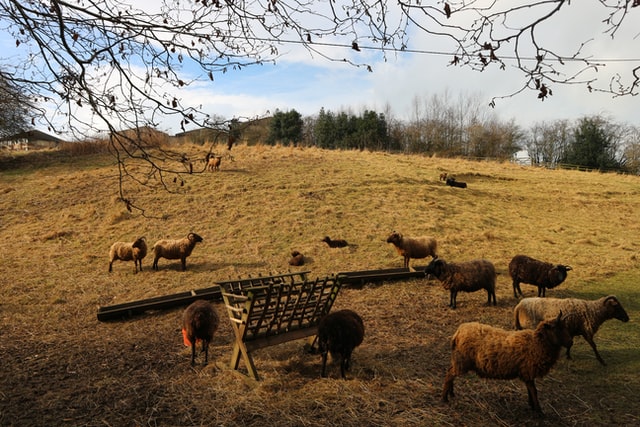
The most important energy sources in your sheep’s diet are browse and pasture, silage, hay, and grains. When setting the diets for your animals, you must ensure that they obtain all the energy they need while ensuring that no overfeeding (and no underfeeding) takes place. In sheep, a deficiency in the energy-content of feed is the most prevalent kind of nutritional deficiency.
There are a number of different ways in which energy can be quantified. TDN is one of the most popular measurements. This is an acronym for “total digestible nutrients.” In the diet of a sheep, however, ME (metabolizable energy) and NE (net energy) is a more accurate form of measurement. It’s true that TDN is often used when deciding on rations for breeding animals. Net energy, on the other hand, is frequently used when formulating diets for lambs (as they’re still growing).
How to Discern Energy Deficiency and Excess
There are a number of signs that look for that can indicate an energy deficiency in your sheep. If the animals are young, you might see a reduction in expected growth, as well as weight loss and even eventually death. With females that are reproducing, an energy deficiency can be signalled by a reduced rate of conception, fewer births of multiple lambs, and less milk production.
Sheep that aren’t getting enough energy in their diets can also experience a reduction in fiber diameter in their wool, slowed wool growth, and breaks (or weak spots) in wool fiber development. Sheep that aren’t getting enough energy in their diets tend to also have compromised immune systems and therefore are more likely to fall victim to diseases such as gastro-intestinal worms.
If sheep are getting an excessive amount of energy in their diets, this can lead to the excess energy being stored in the body as fat (adipose tissue). Too much fat (or adipose tissue) can cause rams and ewes to have problems with reproduction. Also, ewes that are overweight can experience ketosis (also called pregnancy toxemia) during late gestation, as well as dystocia.
Minerals in the Diet for Sheep
There are sixteen minerals that have been determined to be essential in nutrition for sheep. The essential macro-minerals are calcium (Ca), sodium (Na), chloride (CI), magnesium (Mg), phosphorous (P), Sulfur (S), and potassium (K). These are needed in larger amounts. The microminerals that are needed are iron (Fe), copper (Cu), iodine (I), zinc (Zn), manganese (Mn), colbat (Co), molybdenum (M), fluoride (FL), and selenium (Se). These are required in only small amounts. They are also referred to as trace minerals.
Remember that sheep need salt in order for all their bodily functions to carry on as they should. A sheep that isn’t getting enough salt will probably drink and eat less. Inadequate salt can also lead to reduced milk production in ewes and slower growth in lambs. If you notice a sheep trying to eat toxic plants, licking at dirt, or chewing at wood, there might be a deficiency in the animal’s diet. In general, the guideline for adding salt to mixed feed is to add 1 percent in amount to the concentrate portion and 0.3 percent to the complete diet.
Calcium and Phosphorous
Calcium is needed for bone development and strength, reproductive functions, body maintenance, and milk production. Phosphorus must accompany the calcium and is also needed for bone development, energy processes and processes and reproduction. Development and maintenance of the skeleton demands calcium and phosphorus. These minerals come together in their work in this area. Rickets will result when there are deficiencies in these minerals. Male sheep may also experience urinary calculi when there is an imbalance in these minerals. You should be aware that forage rarely has enough calcium for sheep. If you’re feeding a lot of oilseeds that are high in phosphorous and cereal grains, it can be easy to end up having a deficiency in calcium in your sheep. You must take care to ensure that the right balance is being struck. You need to make sure that the diet has a calcium to phosphorus ratio of a minimum of 2:1.
Sheep Nutrition: Protein Requirements for Sheep
Protein is necessary for the development of muscle and bone, maintenance of body condition, and reproductive processes in sheep. For sheep, protein quantity is more significant than protein quality. This is because protein is rendered from amino acids by the rumen. Lambs that are young and still developing need the largest amounts of protein. Lactating ewes also need higher amounts of protein than other sheep.
Soybean meal is among the most prevalent protein supplements used in sheep feed. Peanut meal, whole soybeans, cottonseed meal, sunflower meal, whole cottonseed, alfalfa pellets, fish meal, and canola meal are among some of the less popular sources. In most places around the world, it’s against the law to feed sheep bone meal and meat taken from other ruminants.
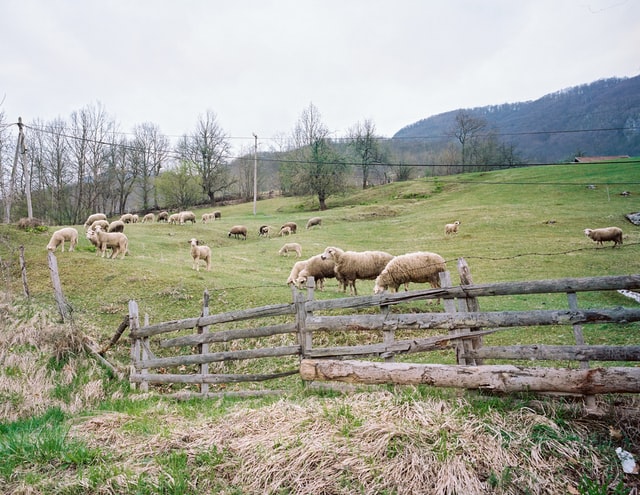
As sheep are ruminants, when they’re mature they are able to utiize the protein and nonprotein nitrogen (also called urea) in their rations in an effective way. Some frequently used sources of natural protein for sheep include peanut meals, linseed, soybean, sunflower, and cottonseed. These are oilseed meals, and they can be between 40 to 50 percent protein in composition. This is why they are so effective as sources of supplemental protein. Urea is commonly included in sheep feed, but it needs to be done so very carefully. It’s an inexpensive protein source (it has dietary nitrogen). Urea is made into protein within the rumen.
Legume hays (as long as they are high in quality) can offer from between 12 and 20 percent protein. This can mean an adequate level of protein for many classes of sheep when they are provided as a complete ration.
Keep in mind that nonprotein sources of nitrogen ought not to be given to young lambs. This is because these animals will not become functioning ruminants until the age of about two months old. This will depend on how quickly they are granted access to forage and grain. When sheep are mature, they can be given small amounts of nonprotein nitrogen.
You should be aware that overall, supplemental nonprotein nitrogen only benefits the animal when there is adequate available energy. Remember that urea ought never comprise more than a third of the diet’s ruminally degradable protein. It’s important to realize that urea can have a toxic effect is its intake is too large over a limited period of time.
How Much Water do Sheep Drink per Day?
Of course, every species requires water in order for body functions to carry forward as they should and for life to be sustained. Unfortunately, it’s quite common for sheep farmers to fail to give their animals as much water as they really need. Sheep need at least from around a half to 4 gallons of water every day. The amount each animal needs depends on environmental conditions and the specific animal’s physical state. A sheep usually needs a per day amount of 1 gallon of water for every 100 pounds of bodyweight.
Sheep generally drink more water when they have diets that are high in protein or salt. Lactating sheep that don’t get enough water may have decreased milk production. Lambs will also have lower rates of growth. Not getting enough water can lead to urinary calculi in sheep.
It’s essential that quality testing be done on water sources for your sheep. Poor quality water will have negative effects on your sheep and the quality of your production. Water can contain a variety of things, including minerals, micro-organisms, pollutants, organic and inorganic compounds, and suspended solids. There are limits to how much in terms of total dissolved solids, sulfates, and nitrates can be in the water before they will start interfering with or threatening sheep health.
Another reason for the importance of water quality is the fact that sheep will generally refuse to drink water that doesn’t taste good or seems stagnant. Remember that sheep need to drink two or three times as much water as they do dry matter. Make sure that there is always abundant water in the feedlots. Lambs tend to eat less than they should when they don’t have enough water.
Dietary Fiber Needs for Sheep
Fiber is necessary because of the bulk it adds to the sheep’s diet. This ensures that the rumen functions as it should and that there is the necessary salivation for good digestion. In general, sheep need a minimum of one pound of fiber per day. A sign that a sheep isn’t getting enough fiber is chewing on wool or wood.
How to Maintain a Sheep’s Weight with Proper Nutrition
In order to maintain each sheep’s weight, the animal must consume enough each day that will cause neither weight gain nor loss. Breeding ewes don’t require much more food than others. An exception to this is if you desire to “flush” the animal. The process of flushing is when you try to have ewes strengthen their body condition before breeding takes place and during the first phase of the breeding season.
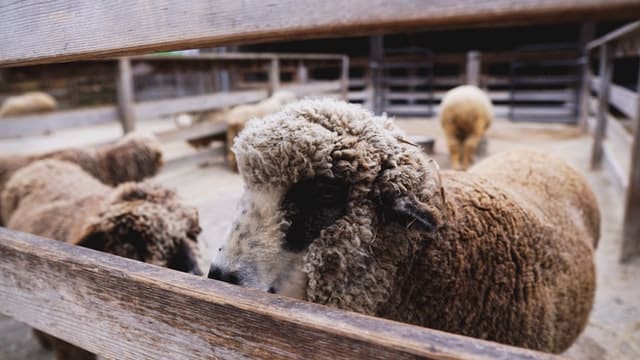
Flushing is generally done by giving the animals supplemental feed. This is usually grain. Another common method of doing this is to move the animal to a higher-quality pasture. The flushing process tends to step up the rate of ovulation and therefore the rate of lambing. If an ewe already has an excellent ovulation rate or is already in outstanding body condition, you probably won’t need to go through the flushing process.
Necessary Vitamins
It’s important that your sheep have enough vitamin E, D, and A in their diets. The latter vitamin is not found in plant material. Rather, it is created from the presence of beta-carotene. B vitamins aren’t required in sheep diets because they are synthesized within the rumen. Vitamin K is needed by sheep for blood clotting. It generally doesn’t need to be added to sheep diets. Vitamin D is important in the prevention of rickets in young sheep, as well as osteomalacia in older sheep.
Lambs sometimes experience white muscle disease in certain areas. This condition is believed to be the result of a vitamin E and/or selenium deficiency. The most effective treatments of this problem are possible with prompt diagnosis and then injection of a vitamin E-selenium material.
Scoring Body Condition in Sheep
Scoring the body condition and weight of your sheep is essential in deciding on and making changes to diets. Decisions about feed management are necessary all through the production cycle. Condition scoring allows producers to measure the amount of the sheep’s fat and muscle at a specific time. The data gained in this process can be utilized to put breeding sheep into categories with regard to body fat. This means that decisions can be made that will ensure the best possible level of profitability.
Body condition scoring of your sheep needs be carried out three times every year. The points at which this should be carried out are at six weeks before breeding, mid-way through pregnancy, and in the late stage of pregnancy. When ewes are condition scores, the person doing the scoring should feel the animal over and in the area of the backbone, behind the last ribs, in the loin area, and above the kidneys. The thumb and fingers should be used in this procedure. A scale from 0 to 5 is used in scoring ewes. The 0 score indicates emaciation. 5 implies an extremely overweight animal. This is why 2.5 is the best possible score when the animal is on a maintenance ration. It should go up to 3.5 before breeding takes place. After breeding takes place, you should keep up a body condition score of around 3.5 for the initial 30 days. This will help to improve the chance of conception.
Nutrition Requirements of Range Sheep
If you have range sheep in New Mexico (or anywhere for that matter), you must remember the importance of knowing the quantity of the forage available in the pasture.
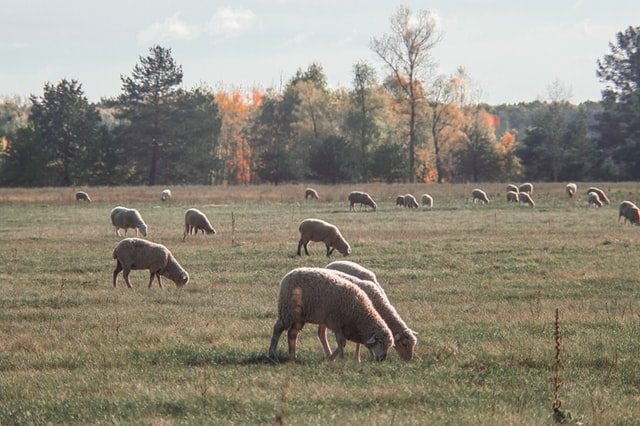
If the amount of forage is adequate but the standing forage is brown and dry in quality, you may need to supplement it with a feed that has a high level of protein. In cases where the amount of forage available is inadequate or if the forage remains a bit green, you’ll probably be able to use a lower-protein supplement (if it’s necessary).
Sheep with the highest need for protein are lactating ewes. This is why they need supplemental protein when the pasture range has forage that has crude protein levels of less than 10 to 12 percent.
Information on Creep Feeding Lambs
Creep feeding is an important method in ensuring that lambs develop well and gain in muscle and weight quickly so that they can be marketed as early as possible.
It’s during the first 100 to 120 days of the lamb’s life that feed is most efficiently converted to weight gain. In the first 70 or 80 days of life, lambs can gain as much as one pound every day. Whenever you can, you should begin your lambs on creep feed as soon as you possibly can after birth. In general, lambs won’t eat very much feed until about 3 to 4 weeks. The tiny amount that they do eat, however, helps to establish strong rumen function in the animal.
You should put the creep feeders in places where the young animals will most likely utilize them. If they’re in pasture area, put the feeders as close as you can to water tanks, supplement or salt feeders, or resting areas. When they’re put in a drylot, position them in protected and dry areas. It’s essential that the starter ration is something that will interest the lambs when they get started. Soybean meal is generally an excellent choice for this purpose. If the cost of soybean meal is prohibitive, alternatives are oat grain, alfalfa pellets, or alfalfa hay.

